| Columns Retired Columns & Blogs |
What is it like with oversampling off? Does it have a perfect response like a NOS DAC? If so this has the best of both worlds, inaudible distortion and good impulse.
I examined the measured behavior of the Bryston BDA-1 using the high-performance Audio Precision SYS2722 system (see www.ap.com and "As We See It" in the January 2008 issue), as well as, for some tests, my Audio Precision System One Dual Domain. To examine its performance as a USB DAC, I drove the BDA-1 with the USB 2.0 output of my MacBook running OS10.4.11, playing WAV files using Bias Peak 6.2. The Bryston identified itself to the host computer as "BRYSTON BDA-1." The BDA-1 offers two modes of operation: the audio data can be processed at their native sample rate, or can be first upsampled to 176.4kHz (44.1 and 88.2kHz data) or 192kHz (48 and 96kHz data). I performed complete sets of measurements in both modes, but comment in the text only where I found any significant difference between the two.
Fed S/PDIF or AES/EBU data, the BDA-1 successfully locked to 16- and 24-bit digital streams with sample rates ranging from 32 to 192kHz, with the exception of 176.4kHz. Peculiarly, trying to feed data at this sample rate to the BDA-1 via TosLink locked the front-panel buttons, mandating a reboot. As expected from its use of a Burr-Brown PCM2707 chip as the USB receiver, the BDA-1's USB input was limited to 44.1 and 48kHz data, with a maximum bit depth of 16.
The processor's maximum outputs were 4.76V from its balanced outputs and 2.38V from the unbalanced ones, the latter 1.24dB higher than the CD standard's 2V RMS. Both sets of outputs preserved absolute polarity; ie, a positive digital pulse was reproduced as a positive analog pulse. The output impedance from the unbalanced RCA jacks was a usefully low 74 ohms at high and middle frequencies, rising inconsequentially to 98 ohms in the low bass. As usual, the output impedance from the balanced XLRs was twice that from the RCAs.
Fig.1 shows the Bryston's frequency response with data at sample rates of 44.1, 96, and 192kHz. The audioband is flat almost to 20kHz, and in each case the ultrasonic rolloff follows the same profile, with a sharp rollout just below the appropriate Nyquist Frequency (half the sample rate). Channel separation (fig.2) was superb, at >125dB below 1kHz and still 113dB at 20kHz.

Fig.1 Bryston BDA-1, frequency response at –12dBFS into 100k ohms at: 192kHz sample rate (left channel green, right gray), 96kHz (left blue, right red), 44.1kHz (left cyan, right magenta). (1dB/vertical div.)
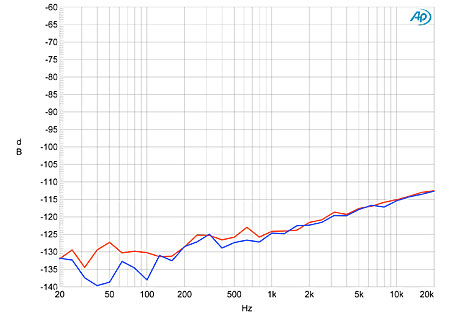
Fig.2 Bryston BDA-1, channel separation (L–R blue, R–L red, 5dB/vertical div.).
For consistency with the tests of digital components Stereophile has published since 1988, I examine resolution by sweeping a 1/3-octave bandpass filter from 20kHz to 20Hz while the unit under test decodes data representing a dithered 1kHz tone at –90dBFS (fig.3). With 16-bit data (top traces), the performance is dominated by the recorded dither noise. Increasing the word length to 24 bits reveals that the BDA-1's true noise floor is 20dB lower in the midrange and treble, implying a resolution of almost 20 bits, which is close to state-of-the-art. No power-supply–related spuriae are visible, and the Bryston readily resolves a tone at –120dBFS (bottom traces at 1kHz). Repeating the spectral analysis with an FFT technique (fig.4) unmasks some very-low-level harmonics with 24-bit data, as well as some odd noise modulation between 1.5 and 3.5kHz. This graph was taken with 44.1kHz data without oversampling engaged; switching in the oversampling raised the levels of the harmonics by up to 10dB (although the highest in level, the fourth and fifth harmonics, still lay at a low –126dB), but the low-treble noise modulation was not affected (fig.5).

Fig.3 Bryston BDA-1, 1/3-octave spectrum with noise and spuriae of dithered 1kHz tone at: –90dBFS with 16-bit data (top), 24-bit data (middle at 2kHz); and dithered 1kHz tone at –120dBFS with 24-bit data (bottom at 1kHz). (Right channel dashed.)
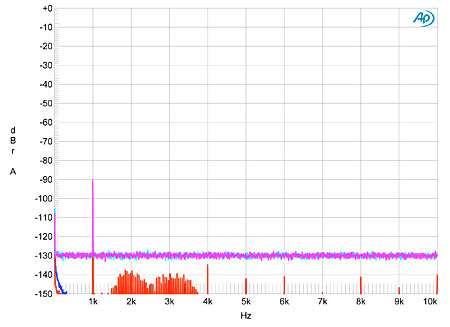
Fig.4 Bryston BDA-1, no oversampling, FFT-derived spectrum with noise and spuriae of dithered 1kHz tone at –90dBFS with: 16-bit data (left channel cyan, right magenta), 24-bit data (left channel blue, right red).
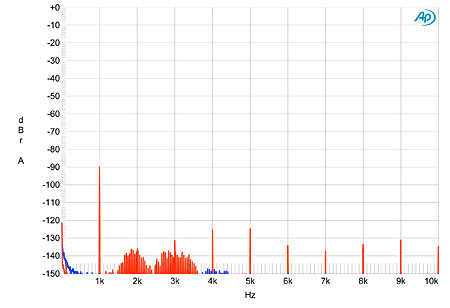
Fig.5 Bryston BDA-1, with oversampling, FFT-derived spectrum with noise and spuriae of dithered 1kHz tone at –90dBFS with 24-bit data (left channel blue, right red).
The plot of the BDA-1's linearity error with 16-bit data (fig.6) revealed only the effect of the recorded dither. However, with its very low noise floor and superb resolution, the Bryston's reproduction of an undithered tone at exactly –90.31dBFS (fig.7) was superb, with the three DC voltage levels well resolved, the waveform perfectly symmetrical about the time axis, and the Gibbs' Phenomenon "ringing" on the waveform tops clearly evident. With undithered 24-bit data (fig.8), the BDA-1 gives a good approximation of a sinewave, despite the low signal level. (For poorer results on this test, see fig.7 in the review of the Playback Designs MPS-5 elsewhere in this issue.)

Fig.6 Bryston BDA-1, Lineairty error with 16-bit data (dBr vs dBFS, 2dB/vertical div.)
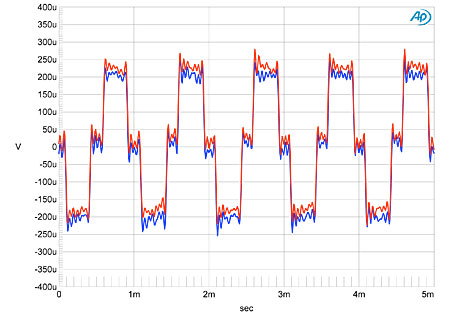
Fig.7 Bryston BDA-1, waveform of undithered 1kHz sinewave at –90.31dBFS, 16-bit data (left channel blue, right red).
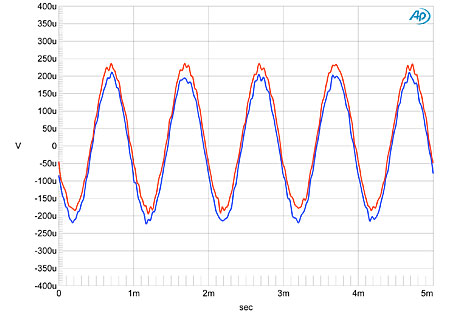
Fig.8 Bryston BDA-1, waveform of undithered 1kHz sinewave at –90.31dBFS, 24-bit data (left channel blue, right red).
The harmonic distortion in the BDA-1's discrete output stage was very low, even into the punishing 600 ohm load (fig.9), though the spectrum was dominated by odd-order spuriae. However, the highest-level harmonic, the third, lay at just –103dB (0.0007%). This behavior was not affected by oversampling, but spectral analysis of a higher-frequency tone again revealed the odd, low-level modulation of the noise floor in the low treble (fig.10). Without oversampling, the BDA-1 performed superbly when fed a high-level mix of 19 and 20kHz tones with 44.1kHz data (fig.11), with all intermodulation spuriae at or below –106dB (0.0005%). With oversampling, however, even though the intermodulation artifacts remain vanishingly low in level, the noise floor is corrupted by a regular series of spikes (fig.12), though these spikes are still very low in level. I did wonder if there were some possible mathematical limitations in the oversampling chip (a Burr-Brown SRC4392), but the Musical Fidelity V-DAC, which uses the same chip, performed fine with this test (see fig.8 in our review).

Fig.9 Bryston BDA-1, spectrum of 50Hz sinewave at 0dBFS into 600 ohms, 24-bit data, no oversampling (left channel blue, right red; linear frequency scale).
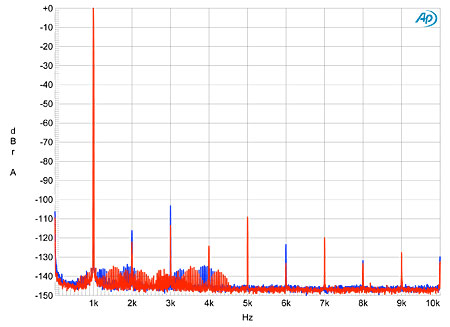
Fig.10 Bryston BDA-1, spectrum of 1kHz sinewave at 0dBFS into 100k ohms, 24-bit data with oversampling (left channel blue, right red; linear frequency scale).

Fig.11 Bryston BDA-1, HF intermodulation spectrum, 19+20kHz at 0dBFS peak into 100k ohms, 24-bit data, no oversampling (left channel blue, right red; linear frequency scale).

Fig.12 Bryston BDA-1, HF intermodulation spectrum, 19+20kHz at 0dBFS peak into 100k ohms, 24-bit data with oversampling (left channel blue, right red; linear frequency scale).
Finally, fed 16-bit data representing a high-level tone at exactly 1/4 the sample rate, over which had been laid an LSB-level squarewave at 1/192 that rate, the Bryston BDA-1 offered moderate suppression of word-clock jitter in the worst case, which was when the data were sourced from an RME soundcard in a PC via 15' of plastic-cored TosLink. The Miller Analyzer calculated there to be 456 picoseconds peak–peak of jitter-related sidebands, primarily at the data-related frequency of 229Hz (fig.13, which also shows some broadening of the central spike due to low-frequency random-noise jitter, particularly in the left channel). Switching in the oversampling didn't reduce the level of jitter—an unexpected result, given the success of this topology in such products as the Benchmark DAC1. Fed data via USB, the jitter dropped to just 98ps p–p (fig.14), though sidebands at the power-supply–related frequencies of ±120Hz, ±180Hz, ±240Hz, and ±360Hz, as well as others at lower levels, are now evident.

Fig.13 Bryston BDA-1, high-resolution jitter spectrum of analog output signal, 11.025kHz at –6dBFS, sampled at 44.1kHz with LSB toggled at 229Hz, 16-bit data sourced from PC via 15' of TosLink. Center frequency of trace, 11.025kHz; frequency range, ±3.5kHz (left channel blue, right red).

Fig.14 Bryston BDA-1, high-resolution jitter spectrum of analog output signal, 11.025kHz at –6dBFS, sampled at 44.1kHz with LSB toggled at 229Hz, 16-bit USB data. Center frequency of trace, 11.025kHz; frequency range, ±3.5kHz (left channel blue, right red).
Overall, and assuming the problem with 176.4kHz data was sample-specific, the Bryston BDA-1 measured very well. Still, I was puzzled by the noise modulation in the low treble, and the less-good performance with oversampling was not what I expected.—John Atkinson

What is it like with oversampling off? Does it have a perfect response like a NOS DAC? If so this has the best of both worlds, inaudible distortion and good impulse.